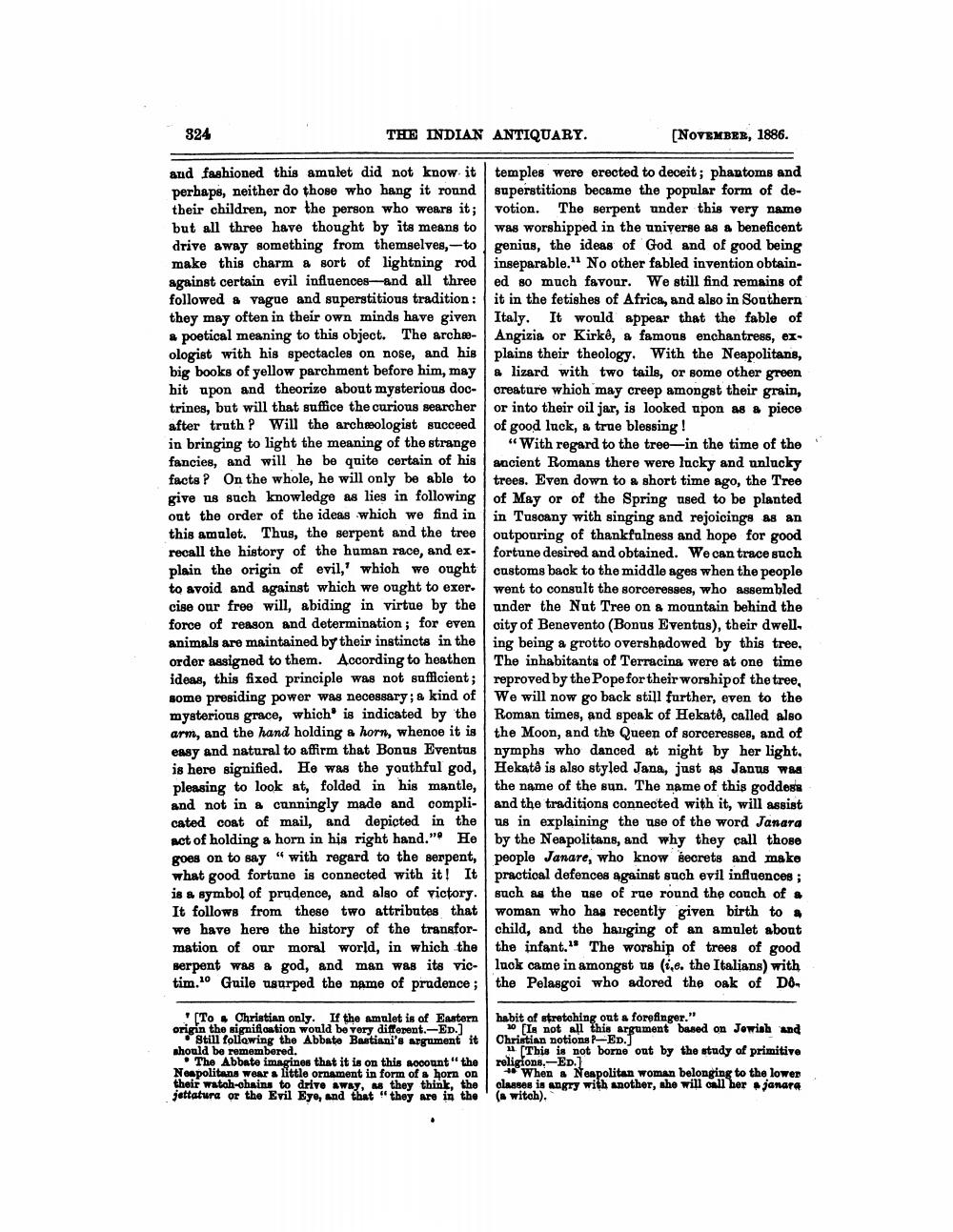________________
324
THE INDIAN ANTIQUARY.
[NOVEMBER, 1886.
and fashioned this amulet did not know it temples were erected to deceit; phantoms and perhaps, neither do those who hang it round superstitions became the popular form of detheir children, nor the person who wears it; votion. The serpent under this very name but all three have thought by its means to was worshipped in the universe as a beneficent drive away something from themselves, - to genius, the ideas of God and of good being make this charm a sort of lightning rod inseparable." No other fabled invention obtainagainst certain evil influences and all three ed so much favour. We still find remains of followed & vague and superstitious tradition: it in the fetishes of Africa, and also in Southern they may often in their own minds have given Italy. It would appear that the fable of a poetical meaning to this object. The arche- Angizia or Kirke, a famous enchantress, ex ologist with his spectacles on nose, and his plains their theology. With the Neapolitans, big books of yellow parchment before him, may & lizard with two tails, or some other green bit apon and theorize about mysterious doc- creature which may creep amongst their grain, trines, but will that suffice the curious searcher or into their oil jar, is looked upon as a piece after truth? Will the archeologist succeed of good luck, a true blessing ! in bringing to light the meaning of the strange “With regard to the tree-in the time of the fancies, and will he be quite certain of his ancient Romans there were lucky and unlucky facts ? On the whole, he will only be able to trees. Even down to a short time ago, the Tree give us such knowledge as lies in following of May or of the Spring used to be planted out the order of the ideas .which we find in in Tuscany with singing and rejoicinge as an this amulet. Thus, the serpent and the tree outpouring of thankfulness and hope for good recall the history of the human race, and ex- fortune desired and obtained. We can trace such plain the origin of evil,' which we ought customs back to the middle ages when the people to avoid and against which we ought to exer.went to consult the sorceresses, who assembled cise our free will, abiding in virtue by the under the Nut Tree on a mountain behind the force of reason and determination ; for even city of Benevento (Bonus Eventus), their dwell. animals are maintained by their instincts in the ing being a grotto overshadowed by this tree. order assigned to them. According to heathen The inhabitants of Terracina were at one time ideas, this fixed principle was not sufficient; reproved by the Pope for their worship of the tree, some presiding power was necessary; a kind of We will now go back still further, even to the mysterious grace, which is indicated by the Roman times, and speak of Hekatd, called also arm, and the hand holding a horn, whenoe it is the Moon, and the Queen of sorceresses, and of easy and natural to affirm that Bonus Eventus nymphs who danced at night by her light, is here signified. He was the youthful god, Hekath is also styled Jana, just 49 Janus waa pleasing to look at, folded in his mantle, the name of the sun. The name of this goddess and not in a cunningly made and compli- and the traditions connected with it, will assist cated coat of mail, and depicted in the us in explaining the use of the word Janara act of holding a horn in his right hand." He by the Neapolitans, and why they call those goes on to say " with regard to the serpent, people Janare, who know secrets and make what good fortune is connected with it! It practioal defences against such evil influences ; is a symbol of prudence, and also of victory such as the use of rue round the couch of a It follows from these two attributes that woman who has recently given birth to a we have here the history of the transfor- child, and the hanging of an amulet about mation of our moral world, in which the the infant." The worship of trees of good Berpent was a god, and man was its vic- luok came in amongst us (ie. the Italians) with tim.o Guile usurped the name of prudence; the Pelasgoi who adored the oak of Do
lillain
To . Christian only. If the amulet is of Eastern origin the signification wonld be very different.-ED.)
Still following the Abbate Bastiani's argument it should be remembered.
The Abbate imagines that it is on this account the Neapolitans wear a little ornament in form of a horn on their watoh-chains to drive away, as they think, the jettatura or the Evil Eye, and that "they are in the
habit of stretching out a forefinger."
30 (Is not all this argument based on Jowish and Christian notions -Ed.
[This is not borne out by the study of primitive religions.—ED.
* When a Neapolitan woman belonging to the lower classes is angry with another, she will call her janara (s witch),




